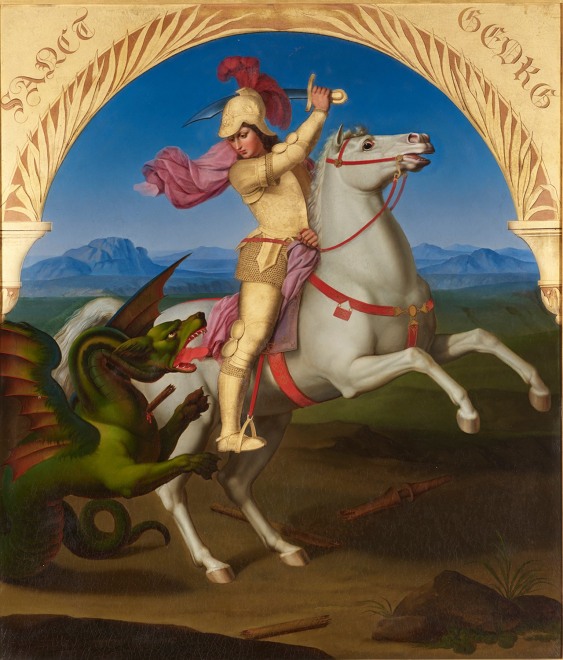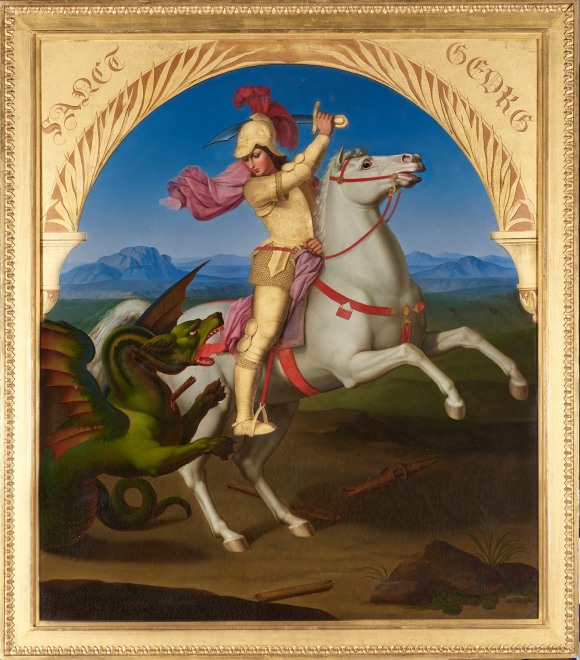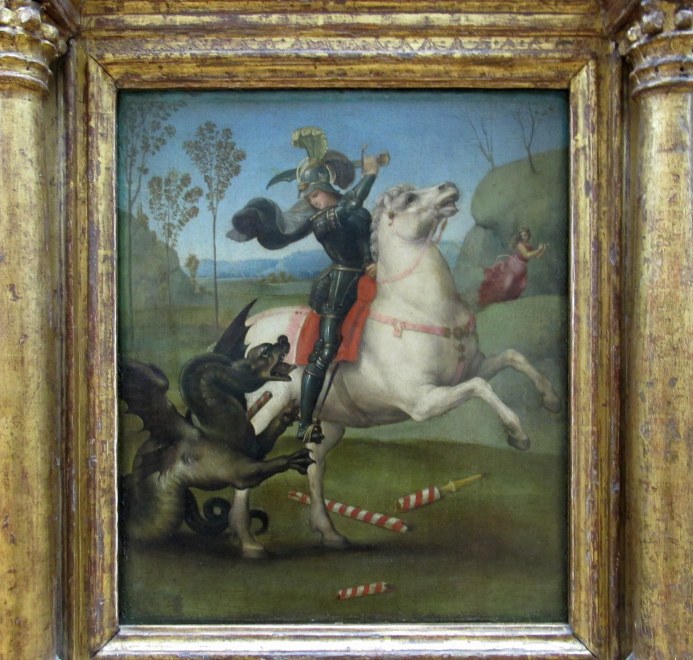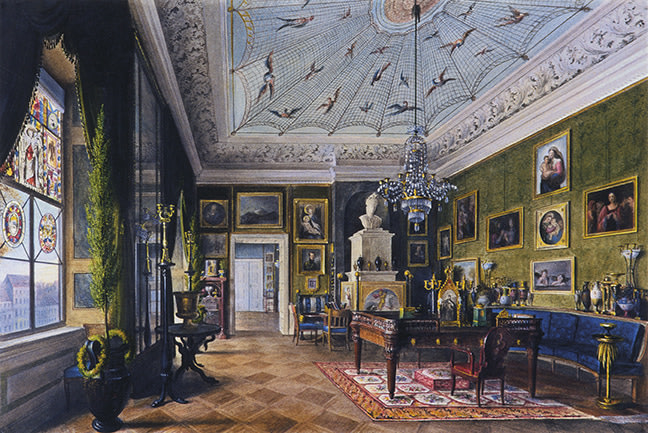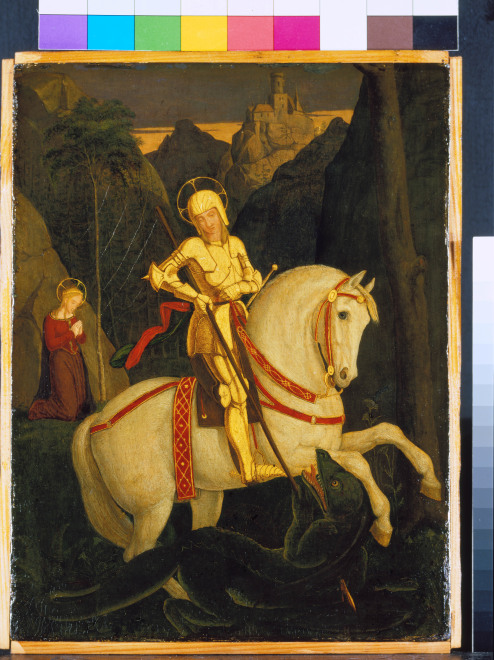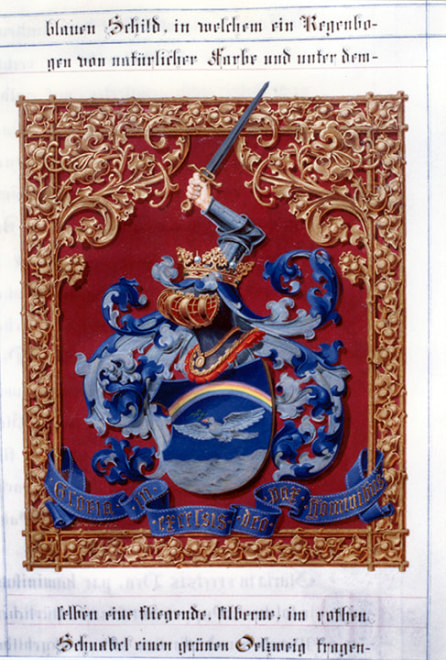Provenance
Princess Marianne of Prussia, Berlin
Thence by descent to her daughter Elisabeth of Prussia
Thence by descent to her son, Prince Heinrich von Hessen und bei Rhein (1838-1900)
Thence by descent to his wife, Emilie (Milena) Hržić Topuska, Freifrau von Dornberg, then Baronin von Bassus (1868-1961) (and sold, Henrici, Berlin, 1929, lot 221, Pl. 11)
Sale, Bolland & Marotz, Bremen, 25-26 October 1996, lot 628.
Sale, Bolland & Marotz, Bremen, 25 June 2011, lot 589
Galerie Volker Westphal, Berlin, 2011
Private Collection, Germany (acquired from the above)
Kunkel Fine Art, Munich, 2021
Private collection, California (acquired from the above)Literature
“Inventory of Paintings owned by Prince Wilhelm of Prussia (1851); house,” Inventarium des Corps 1851 (Gemälde), Inventarium des Corps des Logis und der Etablissements der Hofhaltung Sr. Königl. Hoheit des Hochseligen Prinzen Wilhelm, Berlin, October 1851 (Großherzogliches Familienarchiv Darmstadt, Hessen-Homburg, Box 10 b)
Helmut Börsch-Supan, Marmorsaal und blaues Zimmer : So wohnten Fürsten, exh. cat., Berlin, 1976, p. 90
Cordula Grewe, “Schöne, würdige Heiligenbilder schaffen und den Zopfgeschmack in dieser Region total verdrängen: Zu den Heiligendarstellungen Wilhelm von Schadows,” in Neusser Jahrbuch für Kunst, Kulturgeschichte und Heimatkunde1997, Neuss 1998, p. 13
Cordula Grewe, Wilhelm Schadow (1788-1862), Monographie und Catalogue Raisonné, Dissertation, Freiburg, 1998, vol. 2, no. 16, p. 36.
Cordula Grewe, Wilhelm Schadow: Werkverzeichnis der Gemälde. Mit einer Auswahl der
dazugehörigen Zeichnungen und Druckgraphiken, Petersberg, Michael Imhof Verlag, 2017, no. 22, p. 56-57
Catalogue note
When Wilhelm Schadow (1788-1862) returned to Berlin in 1819, he had made a name for himself as a member of the Lukasbund’s rebellious brethren and a painter of the famous Casa Bartholdy frescoes (see Fig. 8). But coming home was not easy. In 1814, he had converted to Catholicism, and in a country as aggressively Protestant as Prussia, this matter of the heart (as Schadow saw it) came close to treason. Fortunately, some of his most powerful patrons came to his rescue among them Princess Marianne of Prussia (1785-1846), who at the time was furbishing her Berlin apartments with exclusive art and artifacts. The current painting was originally the center of a tripartite fireplace screen flanked by two panels, now lost, with images of the female Saints Barbara and Cecilia. The composition itself recalls Raphael’s famous 1505 work of the same subject matter (Cat. 9a). Acquired by the sun king Louis XIV in 1665 and today housed in the Louvre, the small Renaissance canvas was well-known through reproductions. However, in the act of emulation, Saint George tripled in size and gained its typical Nazarene abstracted look: from the crystalline airlessness and pure local colors to the enigmatic stillness of an otherwise highly dramatic scene that now seems frozen in mid-air. While the landscape breathes a close observation of nature, the horse and its rider display a willful artifice, decorative rather than life-like. Inscribed into the picture plane by the mellifluous flow of sharp contours both seem to have just jumped off the page of an illuminated manuscript or an illustrated book. This effect is reminiscent of a fairy tale, not least because of the colors’ stunning luminosity created by the unusual material of the support—copper. As the metal reflects the light back, the enamel-like surface begins to glow as if illuminated by an interior light. In the original setting, with the flickering light of the fireplace and surrounding candles, the effect must have been quite magical. Originally ensconced in a massive, gilded wood encasing, the work’s large dimensions and elaborate frame emphasize its artistic ambitions.
Not surprisingly, the work’s patrons, Prince Wilhelm of Prussia (1783-1851) and his wife, Princess Marianne (1785-1846), were as illustrious as the object was luxurious. Commissioned in the early 1820s, the fire screen occupied a prominent place in couple’s apartments located in the Hohenzollern’s city palace in Berlin (Cat. 9b). The screen’s theme and style were part of a carefully curated total work of art dominated by the Italian presence of Raphael (1483-1520), then venerated by Romantics across Europe as artistic ideal and idol. The couple’s so-called “Green Room” boasted several Raphael copies, most prominently—above the sofa—partial copies of his famous Sistine Madonna as well as a copy of his charming Madonna alla Sedia. These canvases not only reflect the era’s rampant Raphael-cult and fascination with copies after the old masters, which, as highly prized collector items, played a vital role in the period’s collecting practices and aristocratic self-representation. They particularly paid homage to the role assigned to Raphael as the “alter ego” of the Royal House of Hohenzollern. The Prussian Royal family revered the Renaissance master as a man who had created a visual universe that could (and should!) shape the mind of its 19th-century audience: an art of beauty rooted in a purified spirituality that was morally uplifting and thus a much-needed defense against the period’s alleged cultural decline. Believing in their Gottesgnadentum (the divine right to rule), the Hohenzollern saw in Raphael more than merely a great artist; he was a moral and aesthetic compass, and the future Friedrich Wilhelm IV (1795-1861) even stylized himself and his role as king as that of an artist, who forges the greater good through divinely inspired genius. Looking at Raphael thus presented a vital element of self-formation.
Not surprisingly, Raphael played—whether as immediate, truthful copy or artistic adaption—an exceptional role in decorating the King and Queen’s living quarters, and that of their offspring. Ultimately, this belief fueled a passion for collecting high-end copies after the Renaissance master’s iconic pieces, which, in turn, would find its most spectacular expression in the construction of a lavish exhibition room solely dedicated to the display of the Royal family’s remarkable and remarkably comprehensive collection of Raphael copies. Here, in the Rafael-Saal of the Orangery Schloss in Potsdam, the museum became a sacrosanct temple with the goal to inspire heart and soul rather than merely teach history. Saint George Slaying a Dragon must be understood within this context.
If the turn to Raphael was driven by educational deliberations and an aspiration for character-formation, the motif of Saint George was also chosen for its emphatically political connotations. If the Raphael-Madonnas so prominent in the Green Room’s 1830 decoration were geared toward spiritual uplift, the motif of Saint George pointed to the Hohenzollern’sidentification with the knightly saint as a symbol of anti-Napoleonic (and subsequently anti-revolutionary) resistance, an idea and identification shared by the members of the artists collective, the Lukasbund, that Wilhelm Schadow had joined in 1813 during his Italian studies(Cat. 9c). In particular, Philipp Veit, the later director of Frankfurt’s Städel’sche Kunstinstitutwith its museum and art school, would paint Saint George throughout his life as a kind of spiritual self-portrait. Last but not least, he would remain a meaningful subject for Schadow as well (Cat. 9d). When the painter was knighted in 1843, he adopted Saint George as a symbol of combat readiness to which he added, as an affirmation of eternal hope, a rainbow and a dove, those Old Testament signs that the Flood was subsiding and land in sight. Hence, the decision to decorate the Royal fire screen with a Saint George was clearly driven by iconographic deliberations and carried deep allegorical meaning: Saint George holds back the flames just as the Hohenzollern have defeated Napoleon, the “French Antichrist,” and have become a bastion against the threats of unbelief and revolutionary unrest. In short, with its unusual provenance, stunning wall-power and exceptional historical importance, Saint George Slaying a Dragon presents a unique and beautiful embodiment of the aesthetics, moral values and political ideals of the Royal House of Prussia.
The first documentation of the work was itself in visual form. It is clearly visible in a gouache (dated before 1840), before it is listed a decade later in the 1851 inventory of the possessions of Prince and Princess Wilhelm after Marianne’s death in 1846. When Wilhelm passed, too, in 1851, the inventory was split among various family members and the work ended up in the possession of the house of Hessen-Darmstadt, ultimately being part of the collection of a Baronin von Bassus, who had married a Prince of Hessen-Darmstadt. While the inventory provides a detailed description of the work, it does not provide—as in many other instances—a name, a lacuna filled when the painting was auctioned off in 1929. When the work briefly resurfaced in 1996, the attribution to Wilhelm Schadow was confirmed by Helmut Börsch-Supan(August 20, 1996), who dates the work for stylistic reasons in the years immediately after Schadow’s return to Berlin in 1819. This dating takes into consideration the particularly close contact between Schadow and his major patron, Princess Marianne, in these years (1819-1826) when he also painted a major family portrait of the princess and her three children. Moreover, the Kurpfälzisches Museum in Heidelberg owns a copy after Raphael’s Maria with Christ Child and John the Baptist, attributed to Schadow and dated around 1820 (Oil on panel, 42.5 x 30 cm); this is important insofar as both of these Raphael paintings are in the Louvre and thus point to an intense occupation on the artist’s part with the “French Raphaels.” The material and the usage could give some pause because it might seem unusual for a major artist to decorate a fire screen and thus an object of applied arts. On the other hand, the work is clearly conceived as a major painting. Not coincidentally, the work’s function changed in its ensuing collection-history, as it was repurposed as a fully autonomous, self-standing piece meant to be displayed in the manner of an individual painting.
The period around 1819, when his Roman sojourn (1811-1819) came to an end and Schadow had not yet found his footing in Berlin yet (1819-1822) was a period of experimentation. The painter tried out several different avenues, from an emphatic old-German idiom in his 1818 Christ on his Way to Calvary (Copenhagen) to the one-off pagan Neoclassicism of his 1820 Bacchanal (plafond of Schinkel’s Berlin playhouse, destroyed in WWII). Unfortunately, documentation for this important transition period is sparse, and in contrast to his Düsseldorf years, only a handful of letters have survived; the same holds true for the loss of several works executed in these years, which would help to paint a better picture of Schadow’s stylistic evolution after the disbanding of the Lukasbund. Hence, his Saint George stands out. While Schadow executed several drawings of saints early in his career (and would return to the subject matter once more in the 1840s), the work for Princess Marianne embodies an exception, and does so both in terms of execution and in terms of motif.
Cat. 9 Figures:
Cat. 9a Raphael, Saint George and the Dragon, 1505, oil on panel, 25.5 x 29.4, Louvre, Paris
Cat. 9b Anonymous German artist, Green Room in the Apartment of Prince Wilhelm and Princess Marianne, before 1840, pencil/cover colors, 17.4 x 25.9 cm, Schloss Wolfsgarten beiLangen, Hessische Hausstiftung.
Cat. 9c Franz Pforr, Saint George and the Dragon, c. 1811, oil on panel, 28 x 21 cm, Städel Museum, Frankfurt.
Cat. 9d Anonymous, Coat of Arms, detail from Letter of Nobility for the Director of the Art Academy in Düsseldorf Friedrich Wilhelm Schadow, 1858, pen and watercolor on paper, 41 x 31 cm, Stadtmuseum Düsseldorf.

